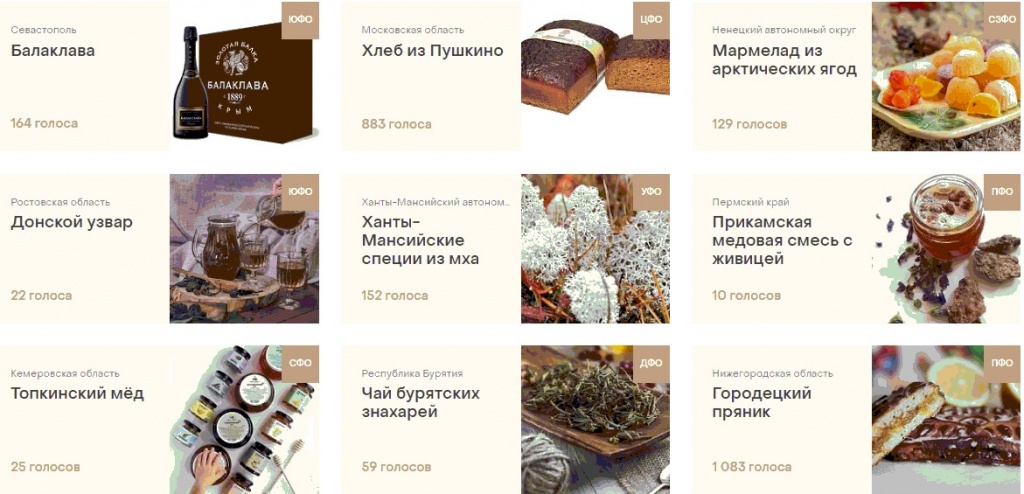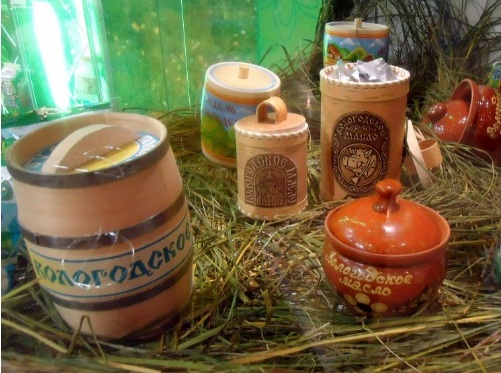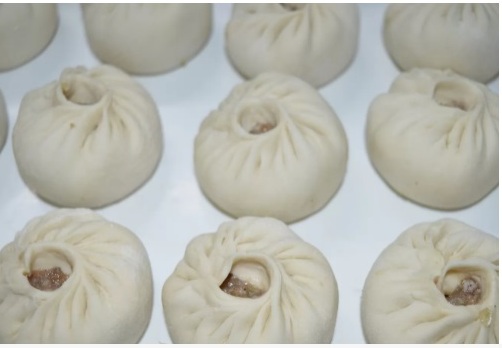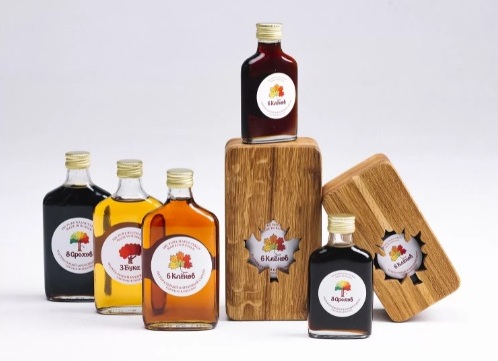
Delicious tastes of Russia
/ Главная / Russkiy Mir Foundation / Publications / Delicious tastes of RussiaDelicious tastes of Russia
Svetlana Smetanina

The Tastes of Russia National Competition for Regional Food Brands was held for the second time in a row in Russia. Everyone could participate in online popular vote and choose their favorite products in three different regions until November, 7. There are 8 nominations in the competition. The winners are to be chosen from 720 brands from all regions of Russia.
Kologrivsky goose and Buryat buuz
Tastes of Russia, the first National Competition held by the Ministry of Agriculture of the Russian Federation last year, aroused great interest among the residents who actively voted for 491 brands from 79 regions. Over a million votes were cast in the online voting.
24 finalists won in eight nominations. In “For the whole country” category the winners were such brands as Vologda Butter, Adygeyskiy Cheese and Bashkirskiy Honey. And it's hard to argue with this choice because all three products are widely known and popular in Russia.
Vologda butter (or Vologodskoye maslo) has been produced in Russia from the year 1876. By the way, it was originally known as Parisian butter, because its creator Nikolay Vereshchagin (brother of Russian war artist Vasily Vereshchagin) was inspired by the Normandy butter that participated in the World Dairy Exhibition in Paris in 1870. In 1911, a Dairy Institute in Vologda city was established to develop the buttermaking in Russia. In 1939, by the order of the People's Commissariat of the Meat and Dairy Industry of the USSR, Vologda butter has received its name, familiar to everyone nowadays. Today it is produced according to a special technology at the enterprises of the Vologda Region and has a special “nutty” aftertaste. Today there are many more brands on the market, but the Vologda butter is still incredibly popular in Russia.

Photo: Vologda butter
The winner in the nomination "From our village" in 2020 was the Kologrivsky Goose brand from the Kostroma region. Until recently, only few knew about Kologriv city in the Kostroma region. After winning the national brand competition, the Kologrivsky Goose name was widely recognized. It turns out that it’s possible to observe several species of geese at once for about a month only in one Russian city of Kologriv. Recently, Kologriv even received a second name - "The Goose Capital of Russia." Every spring tens of thousands of wild birds migrating from Europe to the Arctic stop here and have a kind of "resort" before flying to the polar tundra, where they breed. It is not surprising that Kologriv attracts international scientists and more recently tourists. Since 1999, Kologrivski Forest Nature Reserve estate handles several hundred hectares of flooded meadows and a goose wildlife area.
In 2015, after graduating from the university, several students moved to Kologriv and organized their own subsidiary farm, raising the local breed of geese. The local breed claims special ecological purity of production: there are no industrial enterprises within a radius of 300 kilometers around.

Photo: Buryat buuzy
Buryat buuz has won in the "We are chosen-2020" nomination. A steamed dumpling filled with meat is a traditional dish of the Buryat and Mongolian peoples. The mixture of mutton, beef, horse meat and pork, plus onion and garlic is used for these dumplings. A distinctive feature of buuzy is the meat broth inside the round purse shape. This way it’s an unusual combination of the first and second courses in one. The locals always emphasize: no knives, spoons or forks are acceptable in the eating the special dumplings. They are handled by hands: take a bite, drink the broth, then eat the rest. The history of this national dish began over 400 years ago: Tibetan lamas’ head invited the Buryats to visit, and ordered to prepare meat wrapped in dough for their arrival. The balls of minced meat were wrapped in dough, leaving a small hole with 33 folds twirled to a close, according to the number of folds in the clothes of Tibetan lamas. Another legend says that the buuz designed in accordance with round yurt tent structure.
Russia, the birthplace of maple syrup
This year, 720 applications, twice as much as a year before, participated in the competition. 84 regions were taking part in the contest. Only Moscow region received 44 applications at once. Among the competitors are Posad gingerbread, Kolomensk snail, Mozhaisk milk, Serpukhov metballs with onions, buckwheat bun from Volokolamsk, and Kolomna marshmallow. Another rare dish is Lukhovitsky Clarias catfish originally coming from African reservoirs. It turned out that this fish is a real delicacy, full of omega-3 and omega-6 oils is three times higher than in salmon.

Photo: Stepanovsk cheese caramel
Stepanovsk cheese caramel is another unusual desert from the Tomsk region. It was named after the merchant Stepan Sosulin, who opened the first confectionery shop in Tomsk city in 1858. The cheese caramel contains very tender ricotta cheese, chocolate, and pine nuts that are well-known Siberian speciality. Such caramel is malleable and soft and plastic. It can be spread on bread and used as a filling for buns.
Kamchatka Krai is famous for its variety of fish and seafood. Recently, the production of a fish sausage has been popular here. This cold appetizer is prepared from minced fish with the addition of fish pieces. In total, Kamchatka offered six local brands for the competition. In addition to a fish sausage, there are Kamchatka sockeye salmon, Olyutorskaya herring, Ivan tea with dried berries, Kamchatka honeysuckle and even Kamchatka fern, a popular dish of oriental cuisine.

Photo: tree saps from Voyeykovo
Many people associate maple syrup exclusively with Canada. But local historians from the village of Voyeykovo in the Leningrad oblast believe that European immigrants from Voyekovo could have brought the syrup recipes to Canada. Today, the village manufacturers are worldwide leaders in the birch sap syrup production and the maple syrup production on the European continent. The harvesting season for the birch sap in the Leningrad Region is 55 days, which is the longest in the world. The first mentions of the production of maple syrup in this area date back to the beginning of the 18th century, well before then in Canada and the USA.
Tastes of Russia National Competition for Regional Food Brands organizers are making sure that the contest presents Russia not only from the tourist perspective, but also from the yummy side.
New publications

 Mikhail Kalatozov, a director who transformed the world of cinematography in many ways, was born 120 years ago. He was a Soviet film official and a propagandist. Above all, he was capable of producing movies that struck viewers with their power and poetic language.
Mikhail Kalatozov, a director who transformed the world of cinematography in many ways, was born 120 years ago. He was a Soviet film official and a propagandist. Above all, he was capable of producing movies that struck viewers with their power and poetic language.  Ukrainian authorities have launched a persecution campaign against the canonical Ukrainian Orthodox Church (UOC), the biggest one in the country's modern history. Over the past year, state sanctions were imposed on clergy representatives, searches were conducted in churches, clergymen were arrested, criminal cases were initiated, the activity of the UOC was banned in various regions of the country, and monasteries and churches were seized.
Ukrainian authorities have launched a persecution campaign against the canonical Ukrainian Orthodox Church (UOC), the biggest one in the country's modern history. Over the past year, state sanctions were imposed on clergy representatives, searches were conducted in churches, clergymen were arrested, criminal cases were initiated, the activity of the UOC was banned in various regions of the country, and monasteries and churches were seized.  When Nektary Kotlyaroff, a fourth-generation Russian Australian and founder of the Russian Orthodox Choir in Sydney, first visited Russia, the first person he spoke to was a cab driver at the airport. Having heard that Nektariy's ancestors left Russia more than 100 years ago, the driver was astonished, "How come you haven't forgotten the Russian language?" Nektary Kotlyaroff repeated his answer in an interview with the Russkiy Mir. His affinity to the Orthodox Church (many of his ancestors and relatives were priests) and the traditions of a large Russian family brought from Russia helped him to preserve the Russian language.
When Nektary Kotlyaroff, a fourth-generation Russian Australian and founder of the Russian Orthodox Choir in Sydney, first visited Russia, the first person he spoke to was a cab driver at the airport. Having heard that Nektariy's ancestors left Russia more than 100 years ago, the driver was astonished, "How come you haven't forgotten the Russian language?" Nektary Kotlyaroff repeated his answer in an interview with the Russkiy Mir. His affinity to the Orthodox Church (many of his ancestors and relatives were priests) and the traditions of a large Russian family brought from Russia helped him to preserve the Russian language.

 The leaders of the Friends of the Great Russia cultural association (Amici Della Grande Russia) in Italy believe that the Western policy of abolishing Russian culture in Europe has finally failed. Furthermore, it was doomed to failure from the beginning.
The leaders of the Friends of the Great Russia cultural association (Amici Della Grande Russia) in Italy believe that the Western policy of abolishing Russian culture in Europe has finally failed. Furthermore, it was doomed to failure from the beginning.  Name of Vladimir Nemirovich-Danchenko is inscribed in the history of Russian theater along with Konstantin Stanislavski, the other founding father of the Moscow Art Theater. Nevertheless, Mr. Nemirovich-Danchenko was a renowned writer, playwright, and theater teacher even before their famous meeting in the Slavic Bazaar restaurant. Furthermore, it was Mr. Nemirovich-Danchenko who came up with the idea of establishing a new "people's" theater believing that the theater could become a "department of public education."
Name of Vladimir Nemirovich-Danchenko is inscribed in the history of Russian theater along with Konstantin Stanislavski, the other founding father of the Moscow Art Theater. Nevertheless, Mr. Nemirovich-Danchenko was a renowned writer, playwright, and theater teacher even before their famous meeting in the Slavic Bazaar restaurant. Furthermore, it was Mr. Nemirovich-Danchenko who came up with the idea of establishing a new "people's" theater believing that the theater could become a "department of public education."  "Russia is a thing of which the intellect cannot conceive..." by Fyodor Tyutchev are famous among Russians at least. December marks the 220th anniversary of the poet's birth. Yet, he never considered poetry to be his life's mission and was preoccupied with matters of a global scale. Mr.Tyutchev fought his war focusing on relations between Russia and the West, the origins of mutual misunderstanding, and the origins of Russophobia. When you read his works today, it feels as though he saw things coming in a crystal ball...
"Russia is a thing of which the intellect cannot conceive..." by Fyodor Tyutchev are famous among Russians at least. December marks the 220th anniversary of the poet's birth. Yet, he never considered poetry to be his life's mission and was preoccupied with matters of a global scale. Mr.Tyutchev fought his war focusing on relations between Russia and the West, the origins of mutual misunderstanding, and the origins of Russophobia. When you read his works today, it feels as though he saw things coming in a crystal ball...